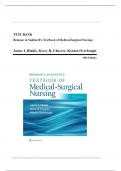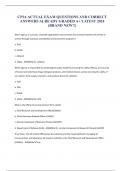Exam (elaborations)
Test Bank for Brunner & Suddarth-s Textbook of Medical-Surgical Nursing, 15th Edition (Hinkle, 2022), All Chapters
- Course
- Institution
Test Bank for Brunner & Suddarth-s Textbook of Medical-Surgical Nursing, 15th Edition (Hinkle, 2022), All Chapters
[Show more]




